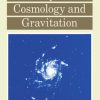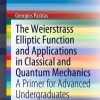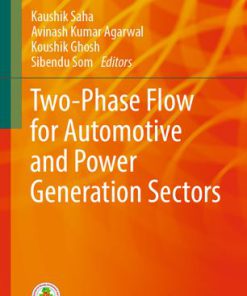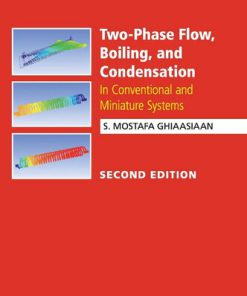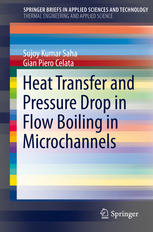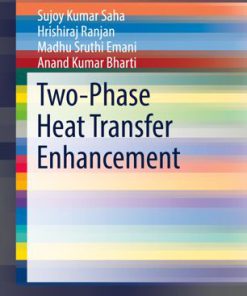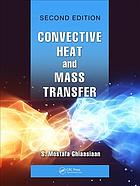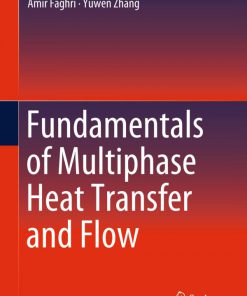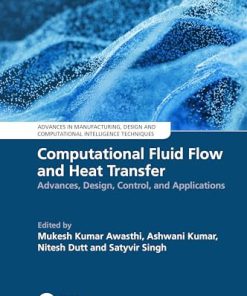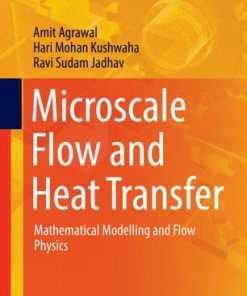Boiling Heat Transfer and Two Phase Flow 2nd Edition by Yu Tang, Long sun Tong 1351463362 9781351463362
$50.00 Original price was: $50.00.$25.00Current price is: $25.00.
Boiling Heat Transfer and Two-Phase Flow 2nd Edition by Yu S. Tang, Long-sun Tong – Ebook PDF Instant Download/DeliveryISBN: 1351463362, 9781351463362
Full download Boiling Heat Transfer and Two-Phase Flow 2nd Edition after payment.
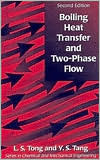
Product details:
ISBN-10 : 1351463362
ISBN-13 : 9781351463362
Author: Yu S. Tang, Long-sun Tong
Completely updated, this graduate text describes the current state of boiling heat transfer and two-phase flow, in terms through which students can attain a consistent understanding. Prediction of real or potential boiling heat transfer behaviour, both in steady and transient states, is covered to aid engineering design of reliable and effective systems.
Boiling Heat Transfer and Two-Phase Flow 2nd Table of contents:
1 INTRODUCTION
1.1 Regimes of boiling
1.2 Two-Phase Flow
1.3 Flow Boiling Crisis
1.4 Flow Instability
2 POOL BOILING
2.1 Introduction
2.2 Nucleation and Dynamics of Single Bubbles
2.2.1 Nucleation
2.2.1.1 Nucleation in a Pure Liquid
2.2.1.2 Nucleation at Surfaces
2.2.2 Waiting Period
2.2.3 Isothermal Bubble Dynamics
2.2.4 Isobaric Bubble Dynamics
2.2.5 Bubble Departure from a Heated Surface
2.2.5.1 Bubble Size at Departure
2.2.5.2 Departure Frequency
2.2.5.3 Boiling Sound
2.2.5.4 Latent Heat Transport and Microconvection by Departing Bubbles
2.2.5.5 Evaporation-of-Microlayer Theory
2.3 Hydrodynamics of Pool Boiling Process
2.3.1 The Helmholtz Instability
2.3.2 The Taylor Instability
2.4 Pool Boiling Heat Transfer
2.4.1 Dimensional Analysis
2.4.1.1 Commonly Used Nondimensional Groups
2.4.1.2 Boiling Models
2.4.2 Correlation of Nucleate Boiling Data
2.4.2.1 Nucleate Pool Boiling of Ordinary Liquids
2.4.2.2 Nucleate Pool Boiling with Liquid Metals
2.4.3 Pool Boiling Crisis
2.4.3.1 Pool Boiling Crisis in Ordinary Liquids
2.4.3.2 Boiling Crisis with Liquid Metals
2.4.4 Film Boiling in a Pool
2.4.4.1 Film Boiling in Ordinary Liquids
2.4.4.2 Film Boiling in Liquid Metals
2.5 Additional References for Further Study
3 HYDRODYNAMICS OF TWO-PHASE FLOW
3.1 Introduction
3.2 Flow Patterns in Adiabatic and Diabatic Flows
3.2.1 Flow Patterns in Adiabatic Flow
3.2.2 Flow Pattern Transitions in Adiabatic Flow
3.2.2.1 Pattern Transition in Horizontal Adiabatic Flow
3.2.2.2 Pattern Transition in Vertical Adiabatic Flow
3.2.2.3 Adiabatic Flow in Rod Bundles
3.2.2.4 Liquid Metal-Gas Two-Phase Systems
3.2.3 Flow Patterns in Diabatic Flow
3.3 Void Fraction and Slip Ratio in Diabatic Flow
3.3.1 Void Fraction in Subcooled Boiling Flow
3.3.2 Void Fraction in Saturated Boiling Flow
3.3.3 Diabatic Liquid Metal-Gas Two-Phase Flow
3.3.4 Instrumentation
3.3.4.1 Void Distribution Measurement
3.3.4.2 Interfacial Area Measurement
3.3.4.3 Measurement of the Velocity of a Large Particle
3.3.4.4 Measurement of Liquid Film Thickness
3.4 Modeling of Two-Phase Flow
3.4.1 Homogeneous Model/Drift Flux Model
3.4.2 Separate-Phase Model (Two-Fluid Model)
3.4.3 Models for Flow Pattern Transition
3.4.4 Models for Bubbly Flow
3.4.5 Models for Slug Flow (Taitel and Barnea, 1990)
3.4.6 Models for Annular Flow
3.4.6.1 Falling Film Flow
3.4.6.2 Countercurrent Two-Phase Annular Flow
3.4.6.3 Inverted Annular and Dispersed Flow
3.4.7 Models for Stratified Flow (Horizontal Pipes)
3.4.8 Models for Transient Two-Phase Flow
3.4.8.1 Transient Two-Phase Flow in Horizontal Pipes
3.4.8.2 Transient Slug Flow
3.4.8.3 Transient Two-Phase Flow in Rod Bundles
3.5 Pressure Drop in Two-Phase Flow
3.5.1 Local Pressure Drop
3.5.2 Analytical Models for Pressure Drop Prediction
3.5.2.1 Bubbly Flow
3.5.2.2 Slug Flow
3.5.2.3 Annular Flow
3.5.2.4 Stratified Flow
3.5.3 Empirical Correlations
3.5.3.1 Bubbly Flow in Horizontal Pipes
3.5.3.2 Slug Flow
3.5.3.3 Annular Flow
3.5.3.4 Correlations for Liquid Metal and Other Fluid Systems
3.5.4 Pressure Drop in Rod Bundles
3.5.4.1 Steady Two-Phase Flow
3.5.4.2 Pressure Drop in Transient Flow
3.5.5 Pressure Drop in Flow Restriction
3.5.5.1 Steady-State, Two-Phase-Flow Pressure Drop
3.5.5.2 Transient Two-Phase-Flow Pressure Drop
3.6 Critical Flow and Unsteady Flow
3.6.1 Critical Flow in Long Pipes
3.6.2 Critical Flow in Short Pipes, Nozzles, and Orifices
3.6.3 Blowdown Experiments
3.6.3.1 Experiments with Tubes
3.6.3.2 Vessel Blowdown
3.6.4 Propagation of Pressure Pulses and Waves
3.6.4.1 Pressure Pulse Propagation
3.6.4.2 Sonic Wave Propagation
3.6.4.3 Relationship Among Critical Discharge Rate, Pressure Propagation Rate, and Sonic Velocity
3.7 Additional References for Further Study
4 FLOW BOILING
4.1 Introducton
4.2 Nucleate Boiling in Flow
4.2.1 Subcooled Nucleate Flow Boiling
4.2.1.1 Partial Nucleate Flow Boiling
4.2.1.2 Fully Developed Nucleate Flow Boiling
4.2.2 Saturated Nucleate Flow Boiling
4.2.2.1 Saturated Nucleate Flow Boiling of Ordinary Liquids
4.2.2.2 Saturated Nucleate Flow Boiling of Liquid Metals
4.3 Forced-Convection Vaporization
4.3.1 Correlations for Forced-Convection Vaporization
4.3.2 Effect of Fouling Boiling Surface
4.3.3 Correlations for Liquid Metals
4.4 Film Boiling and Heat Transfer in Liquid-Deficient Regions
4.4.1 Partial Film Boiling (Transition Boiling)
4.4.2 Stable Film Boiling
4.4.2.1 Film Boiling in Rod Bundles
4.4.3 Mist Heat Transfer in Dispersed Flow
4.4.3.1 Dispersed Flow Model
4.4.3.2 Dryout Droplet Diameter Calculation
4.4.4 Transient Cooling
4.4.4.1 Blowdown Heat Transfer
4.4.4.2 Heat Transfer in Emergency Core Cooling Systems
4.4.4.3 Loss-of-Coolant Accident (LOCA) Analysis
4.4.5 Liquid-Metal Channel Voiding and Expulsion Models
4.5 Additional References for Further Study
5 FLOW BOILING CRISIS
5.1 Introduction
5.2 Physical Mechanisms of Flow Boiling Crisis in Visual Observations
5.2.1 Photographs of Flow Boiling Crisis
5.2.2 Evidence of Surface Dryout in Annular Flow
5.2.3 Summary of Observed Results
5.3 Microscopic Analysis of CHF Mechanisms
5.3.1 Liquid Core Convection and Boundary-Layer Effects
5.3.1.1 Liquid Core Temperature and Velocity Distribution Analysis
5.3.1.2 Boundary-Layer Separation and Reynolds Flux
5.3.1.3 Subcooled Core Liquid Exchange and Interface Condensation
5.3.2 Bubble-Layer Thermal Shielding Analysis
5.3.2.1 Critical Enthalpy in the Bubble Layer (Tong et al., 1996a)
5.3.2.2 Interface Mixing
5.3.2.3 Mass and Energy Balance in the Bubble Layer
5.3.3 Liquid Droplet Entrainment and Deposition in High-Quality Flow
5.3.4 CHF Scaling Criteria and Correlations for Various Fluids
5.3.4.1 Scaling Criteria
5.3.4.2 CHF Correlations for Organic Coolants and Refrigerants
5.3.4.3 CHF Correlations for Liquid Metals
5.4 Parameter Effects on CHF in Experiments
5.4.1 Pressure Effects
5.4.2 Mass Flux Effects
5.4.2.1 Inverse Mass Flux Effects
5.4.2.2 Downward Flow Effects
5.4.3 Local Enthalpy Effects
5.4.4 CHF Table of p-G-X Effects
5.4.5 Channel Size and Cold Wall Effects
5.4.5.1 Channel Size Effect
5.4.5.2 Effect of Unheated Wall in Proximity to the CHF Point
5.4.5.3 Effect of Dissolved Gas and Volatile Additives
5.4.6 Channel Length and Inlet Enthalpy Effects and Orientation Effects
5.4.6.1 Channel Length and Inlet Enthalpy Effects
5.4.6.2 Critical Heat Flux in Horizontal Tubes
5.4.7 Local Flow Obstruction and Surface Property Effects
5.4.7.1 Flow Obstruction Effects
5.4.7.2 Effect of Surface Roughness
5.4.7.3 Wall Thermal Capacitance Effects
5.4.7.4 Effects of Ribs or Spacers
5.4.7.5 Hot-Patch Length Effects
5.4.7.6 Effects of Rod Bowing
5.4.7.7 Effects of Rod Spacing
5.4.7.8 Coolant Property (D2O and H2O) Effects on CHF
5.4.7.9 Effects of Nuclear Heating
5.4.8 Flow Instability Effects
5.4.9 Reactor Transient Effects
5.5 Operating Parameter Correlations for CHF Predictions in Reactor Design
5.5.1 W-3 CHF Correlation and THINC-II Subchannel Codes
5.5.1.1 W-3 CHF Correlation
5.5.1.2 THINC II Code Verification
5.5.2 B & W-2 CHF Correlation (Gellerstedt et al., 1969)
5.5.2.1 Correlation for Uniform Heat Flux
5.5.2.2 Correlation for Nonuniform Heat Flux
5.5.3 CE-1 CHF Correlation (C-E Report, 1975, 1976)
5.5.4 WSC-2 CHF Correlation and HAMBO Code
5.5.4.1 Bowring CHF Correlation for Uniform Heat Flux (Bowring, 1972)
5.5.4.2 WSC-2 Correlation and HAMBO Code Verification (Bowring, 1979)
5.5.5 Columbia CHF Correlation and Verification
5.5.5.1 CHF Correlation for Uniform Heat Flux
5.5.5.2 COBRA IIIC Verification (Reddy and Fighetti, 1983)
5.5.5.3 Russian Data Correlation of Ryzhov and Arkhipow (1985)
5.5.6 Cincinnati CHF Correlation and Modified Model
5.5.6.1 Cincinnati CHF Correlation and COBRA IIIC Verification
5.5.6.2 An Improved CHF Model for Low-Quality Flow
5.5.7 A.R.S. CHF Correlation
5.5.7.1 CHF Correlation with Uniform Heating
5.5.7.2 Extension A.R.S. CHF Correlation to Nonuniform Heating
5.5.7.3 Comparison of A.R.S. Correlation with Experimental Data
5.5.8 Effects of Boiling Length: CISE-1 and CISE-3 CHF Correlations
5.5.8.1 CISE-1 Correlation
5.5.8.2 CISE-3 Correlation for Rod Bundles (Bertoletti et al., 1965)
5.5.9 GE Lower-Envelope CHF Correlation and CISE-GE Correlation
5.5.9.1 GE Lower-Envelope CHF Correlation
5.5.9.2 GE Approximate Dryout Correlation (GE Report, 1975)
5.5.10 Whalley Dryout Predictions in a Round Tube (Whalley et al., 1973)
5.5.11 Levy s Dryout Prediction with Entrainment Parameter
5.5.12 Recommendations on Evaluation of CHF Margin in Reactor Design
5.6 Additional References for Further Study
6 INSTABILITY OF TWO-PHASE FLOW
6.1 Introduction
6.1.1 Classification of Flow Instabilities
6.2 Physical Mechanisms and Observations of Flow Instabilities
6.2.1 Static Instabilities
6.2.1.1 Simple Static Instability
6.2.1.2 Simple (Fundamental) Relaxation Instability
6.2.1.3 Compound Relaxation Instability
6.2.2 Dynamic Instabilities
6.2.2.1 Simple Dynamic Instability
6.2.2.2 Compound Dynamic Instability
6.2.2.3 Compound Dynamic Instabilities as Secondary Phenomena
6.3 Observed Parametric Effects on Flow Instability
6.3.1 Effect of Pressure on Flow Instability
6.3.2 Effect of Inlet and Exit Restrictions on Flow Instability
6.3.3 Effect of Inlet Subcooling on Flow Instability
6.3.4 Effect of Channel Length on Flow Instability
6.3.5 Effects of Bypass Ratio of Parallel Channels
6.3.6 Effects of Mass Flux and Power
6.3.7 Effect of Nonuniform Heat Flux
6.4 Theoretical Analysis
6.4.1 Analysis of Static Instabilities
6.4.1.1 Analysis of Simple (Fundamental) Static Instabilities
6.4.1.2 Analysis of Simple Relaxation Instabilities
6.4.1.3 Analysis of Compound Relaxation Instabilities
6.4.2 Analysis of Dynamic Instabilities
6.4.2.1 Analysis of Simple Dynamic Instabilities
6.4.2.2 Analysis of Compound Dynamic Instabilities
6.4.2.3 Analysis of Compound Dynamic Instabilities as Secondary Phenomena (Pressure Drop Oscillations)
6.5 Flow Instability Predictions and Additional References for Further Study
6.5.1 Recommended Steps for Instability Predictions
6.5.2 Additional References for Further Study
People also search for Boiling Heat Transfer and Two-Phase Flow 2nd:
pool boiling heat transfer
film boiling heat transfer
flow boiling heat transfer
nucleate boiling heat transfer
regimes of boiling heat transfer
Tags: Boiling Heat, Transfer, Two Phase, Yu Tang, Long sun Tong
You may also like…
Science (General)
Two Phase Flow for Automotive and Power Generation Sectors Kaushik Saha
Science (General)
Engineering
Convective Heat and Mass Transfer 2nd Edition by Seyed Mostafa Ghiaasiaan 0745690292 9780745690292
Science (General)
Fundamentals of Multiphase Heat Transfer and Flow Amir Faghri
Engineering - Engineering - General & Miscellaneous
Science (General)


